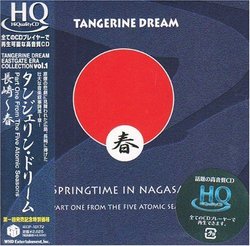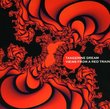| All Artists: Tangerine Dream Title: Springtime in Nagasaki (Mlps) Members Wishing: 1 Total Copies: 0 Label: Whd Japan Release Date: 5/20/2009 Album Type: Import Genres: Dance & Electronic, International Music, Pop, Rock Styles: Ambient, Electronica, Europe, Continental Europe, Progressive, Progressive Rock Number of Discs: 1 SwapaCD Credits: 1 |
Search - Tangerine Dream :: Springtime in Nagasaki (Mlps)
 | Tangerine Dream Springtime in Nagasaki (Mlps) Genres: Dance & Electronic, International Music, Pop, Rock
|
Larger Image |
CD DetailsSimilar CDs
|
CD ReviewsRedolent of cherry blossom in temple gardens Steve Benner | Lancaster, UK | 05/03/2009 (5 out of 5 stars) ""Springtime in Nagasaki" is the opening chapter of Tangerine Dream's five-CD project entitled "The Five Atomic Seasons". The project is the result of a commission from a Japanese business manager, identified only as "Mr HT", who was a student in Nagasaki during the spring and summer of 1945, right up until the A-bomb attack on Hiroshima on 6th August of that year. By sheer chance, HT was out of the city, visiting his parents in Kyoto, when the second A-bomb attack destroyed Nagasaki on August 9th. The commission was highly specific in its requirements, with each CD to be approximately 55 minutes in length and featuring a different season in one of the two destroyed cities. The first two feature Nagasaki, in Spring and Summer respectively, and aim to portray the every day atmosphere of the city prior to the attacks but with the occasional rising premonition of what was to occur. The following two discs form a musical mirror to the opening pair, portraying events in Hiroshima after the attack, through the following Autumn and Winter. The final part is to represent the time afterward as a concluding "endless season". This first CD of the set dates from 2007 and consists of two works of roughly equal length, each divided into three tracks on the disc, delineating the main musical sections. The opening 'Navel of Light' is credited to Edgar Froese as composer; it is highly reminiscent of Tangerine Dream's output during the "Hyperborea" phase but is somehow much more mature and grown up. The instrumentation and themes provide an oriental flavour and it is somewhat reminiscent of "Le Parc", although with a somewhat weightier feel. The music alternates light and airy themes with more sombre and foreboding elements but is always richly textured, featuring the kind of unexpected chord progressions and driving sequencer work which has been largely missing from Tangerine Dream's music since the departure of Chris Franke in 1989. It conjures up city bustle and the vibrancy of springtime perfectly. This opening composition's three parts play continuously with each evolving seamlessly into the next and, indeed, into the second half of the CD, which is a separate piece with Thorsten Quaeschning given the compositional credit. Thorsten first appeared with Tangerine Dream as co-composer on the 2005 release, "Jeanne d'Arc"; his 'Persistence of Memory' marks a major departure from anything that the band have produced before. It is clearly post "Paradiso" as it draws and expands on some of the ideas which feature there. In particular, the piece displays prominent use of analogue instruments in quantities and of a weight that one does not normally associate with TD. In addition, the presence of real-world sounds, in the form of running and dripping water, makes a welcome addition to the Tangerine Dream soundworld and is used here to great effect as a fully integral musical component. Also prominent are solo piano and woodwind, lending a strong oriental flavour. Drifting and contemplative in style, the central section of this composition is highly evocative of temple gardens and orchards of cherry blossom, albeit with the occasional hint of something darker just over the horizon. The concluding third of this work is a lively return to the strong beat and bustle of the disc's opening with a soaring lead line suggestive of the springtime of life itself, not just the year, harking forward to the glories of times to come. The disc concludes in peace, to the fading sound of trickling water. The discs making up "The Five Atomic Seasons" are being made available as limited edition releases by Eastgate (Edgar Froese's publishing company) directly from their online music store but are otherwise in short supply. "Springtime in Nagasaki" was released in March 2007, with "Summer in Nagasaki" following in July of that year. "Autumn in Hiroshima" was released in October 2008; the fourth part, "Winter in Hiroshima", released in August 2009. There is no word at this time on the likely availability date for the concluding part. All in all, "Springtime in Nagasaki" is a highly promising start to what can only be regarded as a very ambitious project. It is easily the best hour's worth of music the band have produced in many a long year and should appeal immediately to all Tangerine Dream fans, regardless of which particularly line-up they personally favour. This is music every bit as fine as anything they have ever recorded and the disc is recommended without reservation." Yes!. 2007 Berlin School of Electronic Music. Eduardo Nava | Mexico City | 08/19/2009 (5 out of 5 stars) " For me, this is an excellent concept album because it perfectly fits into the Classic Electronic-Progressive music style of the early years of Tangerine Dream. The music here gives me the impression that Christopher Franke is back again playing together with TD, but, NO!, it is Thorsten Quaeschning the one that is infusing new blood and ideas to the legendary TD institution. This time, "Springtime in Nagasaki" follows the same path that other groups have been doing it in the 1990's and 2000's, like Airsculpture, Redshift, and Arcane. I really wish TD could compose more albums like this "Springtime in Nagasaki" that complies with the Berlin School of Electronic Music. This is a CD that I keep playing it again and again. I like how it starts, how it evolves, and how it ends. This CD is in my TD rack collection right next to "Pergamon" and "Logos". Of course, it is not the same but, it is a 'modern version of the TD old times'. Saludos from Mexico City." In the Spring a fuller crimson comes upon the robin's breast Mr. A. J. King | uk | 06/20/2009 (4 out of 5 stars) "Tangerine Dream
Springtime in Nagasaki, Eastgate 2007 Produced by Edgar Froese Recorded Feb 2007 at the Eastgate studios Vienna Engineered by Christian Gstettner/ Assistance: Gerd Palkovits Mastered by Harald Pairits Special thanks to Mr H.T, Japan/UDCA Laboratory Vienna/ Timefreezer Marc Link, Berlin and the Vienna Symphonic Library. Tracks by Edgar Froese Navel of Light part 1. Edgar starts the album off with a low dramatic drum note, together with a descending synth or sampled bass guitar note. After a few bars a skipping high hat pattern is introduced. It reminded me more of something from Paradiso, everything quite dry and high up in the mix with usual chord changes we've grown used to from Edgar. This leads into an almost `Jean-Michel Jarre-like' section over a low choir note, with some nice metallic tones and warm synth sweeps, albeit fairly formless without an obvious tempo, here Edgar walks the fine line of holding your interest with timbre alone and just about holds it together with a darker tone taking the centre stage, before the tension dies away once again. More powerful chords are then introduced...leading into Navel of Light part 2. A voice moans, as reversed twittering sounds play with Japanese plucked notes, (I say Japanese but what it actually reminded me of was a hammered dulcimer in tone). Formless and slow, as a languid bass note plays with a choir accompaniment (it reminded me bit of Vangelis in places). It almost doesn't exist, almost stops, sometimes dissolving into single notes, perhaps hinting at a more improvisational approach?). A voice cries out! (the same sound started this track, it was also used by Thorsten on Madcap's Flaming Duty) and then a repeated sequence builds (typical of Edgar's solo work), with long filter sweeps, with parts of melodies that don't seem to develop and just hang for a few seconds only to fall back into the sequence. A buzzy synth is panned left and right as a rhythmic pulse starts (together with a shaker rhythm) and a sampled wordless female opera singer picks out the chord changes for a while. A high arpeggiated sequence is added only to fall away and then reappear. The track builds in power, without any major changes, but now the bass drum can now be heard as well as felt. The sequencer dies away, leaving just the bass and chord changes. An interesting track, albeit perhaps a little too long? I never found it boring, but perhaps the lack of a central theme or strong melody made it seem longer. However, it's nice to hear Edgar using some new synth patches for a change. Navel of Light part 3. A Jarre like choir plays, with an echoed digital `metallic' tone...up and up ...and then back to the beginning. A sequencer starts, quite unlike anything Edgar has tried before, comprising of smaller sections of notes that are built upon or subtracted from as they play, it's hard to describe, it weaves through several key-changes in a rather organic/random manner, and you think it might take off at any moment but it never quite seems to go in the expected way. The track ends with the sound of wind over a choir phrase and a wavetable synth timbres, as well as other diverse sounds sush as echoed digital clangs and a voice-like element through a wah wah effect...which leads into: Tracks by Thorsten Quaeschning Persistence of Memory part 4. Starts with a brisk (although thankfully not `club like') four-on-the-floor rhythm, with a sinuous synth/voice hybrid lead that drifts in and out. Sampled sax is introduced (think Vangelis on his the City album) with distorted guitar chord backing. Almost like Pete Namlook in places until brass stabs are introduced for a few bars, with the sound of water flowing and dripping building in the background. Thorsten once again shows what he can do with a varied palette of new timbres over a static beat. Persistence of Memory part 5. This track starts with a `Vangelis-like' intro, a bit like a modern version of Albedo 0.39. With (panned) loops slowly cycling, creating a languorous tempo with dripping water samples. The track even includes a few seconds from Vivaldi's the Four Seasons. A nice filter effect leads into a slightly darker section and its here that a grand piano is introduced; sounding somewhat like Suzanne Cianni meets Johannes Schmoelling (although not as New-Age as that might suggest), augmented with some fuzzed guitars, it gives an emotional edge to this track. The main piano melody dies away leaving a subtle (and perhaps more ominous) feeling, hinting at the true horror that was Nagasaki's near future. The track ends with more water and a single drum hit....leading into... Persistence of Memory part 6. Almost Vangelis like in places, with chugging bass synths, and a soft chord backing, then drums are added with a rather aimless synth solo (the actual sound and melody are a bit weak for me), it actually reminds me of Anthony Philips often overlooked album "1984". There's some nice drum interplay from Thorsten. It ends quite suddenly and the rushing water returns to fade. Overall it gets an 7.5 out of 10 from me" |

 Track Listings (6) - Disc #1
Track Listings (6) - Disc #1

